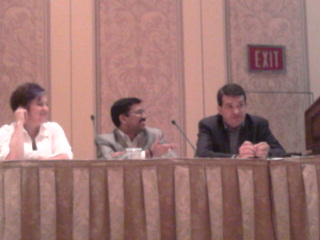How to pitch SOA to the business: 3 CIOs tell all

“The best weapon against resistance to SOA is small wins. Don't start with the biggest, hairiest monster. Start small, with positive data points. You'll find experience is an amazing teacher.”
That's the view of Denise Hatzidakis, CTO of Premier Healthcare, who joined other practitioners as part of an illuminating panel discussion held at this week's IBM Impact conference in Las Vegas.
Hatzidakis explained how her organization, a forms improvement alliance that serves more than 2,500 hospitals and 80,000 healthcare facilities nationwide, employed SOA to build a platform to serve its constituents. She was joined by Mahi Inampudi, CIO of Cars.com, and Rodrigo Corumbo, CIO of Banese Bank, in a panel moderated by IBM’s Alan Glickenhouse.
“Don't talk about SOA to the business,” Hatzidakis advised. “Take it out of your vocabulary. Talk to the business in a language they can understand, a business vocabulary.” For Premier Healthcare, data is king, and the organization's “common service is a common data model,” she explains. “all other services evolved out of that data model.”
For Inampudi, SOA was a hard sell to his business over the years, even though service-orienting promised to make things a lot easier for users, as well as improve time to market. What eventually made the difference, he says, was a move away from waterfall development – in which business users didn't see projects until their rollouts – to Agile development, which involved faster, more frequent incremental rollouts with the business. “we keep putting stuff into production every two weeks,” he says.
Cars.com now maintains three classifications of REST services within its repository, including IT entity services, business activity services and business process services.
For Hatzidakis, however, an Agile approach was not always the best route to SOA success. While Agile worked well when modernizing existing systems, “you need waterfall for greenfield projects,” she says. “SOA doesn't give you a way to connect the dots. You need a couple of design sprints.”
Corumbo did gain the support of his business management as he moved SOA forward incrementally. With an enterprise service bus orchestrating service deployments within the bank, Banese is in its third wave of SOA, which began in 2007. We started the process service-enabling our [interactive voice response] channel, and gave replaced 100 legacy systems,” says Corumbo. The next step, he says, is to move operations unto the cloud. “With an SOA design approach, we'll be enabled to have a cloud business model.”
What kinds of metrics helped the managers track the success of their programs? For Cars.com, latency was the ultimate business metric. “It's about throughput and response times, says Inanpudi, whose operation typically supports 700 concurrent service requests per minute.
At Banese Bank, key business metrics are based on comparisons to a baseline established before SOA was initiated, says Corumbo. “We measure costs, profits, and quantities of clients.” He adds that SOA proponents need to “show that using a more automated approach results in a more profitable solution.”
For Hatzidakis, funding SOA efforts presented a challenge, as SOA-aware services tended to cost up to twice as much as a standard service – though the first reuse of a service may be half the initial cost, and second reuse will be one-quarter that cost. “The harder part is funding and measuring the reuse and how you stricture it,” she says. Inanpudi agreed, observing that “building a service that will be reused takes more time.” He adds: “Give a very realistic picture of what it takes. Explain to the business that it's going to cost more, but but you’re going to get these benefits.”
Transparency is another key requirement for the success of an SOA effort, says Corumbo. “The business user needs to understand how the IT development process works.”
At Cars.com, services are evaluated on their relevancy and usefulness to the business. “We look at the meaning of the service, and why we built it collectively,” says Inampudi. “When we put all the services together, do they form a platform?” Another aspect that helped drive success was positioning SOA as the underpinning of shared services for the business. “The minute you tell a businessperson that they own a service, it suddenly gets better,” he quips.
